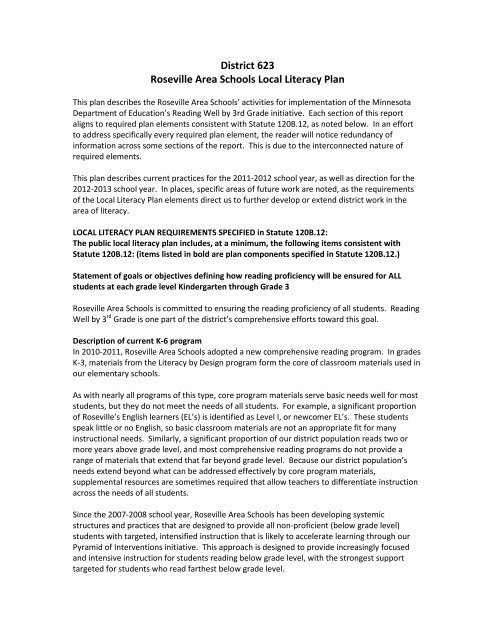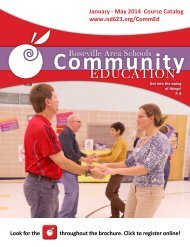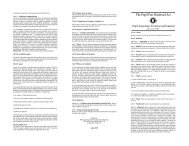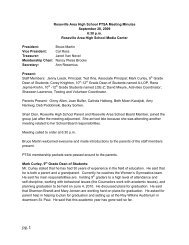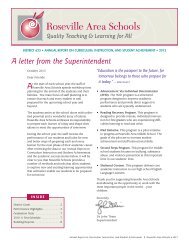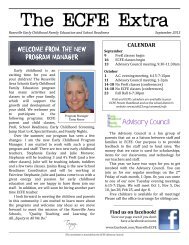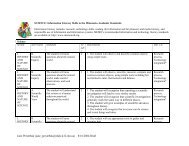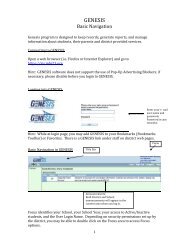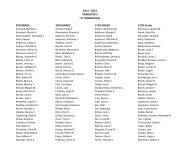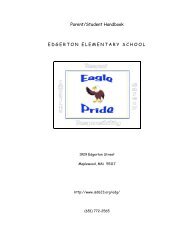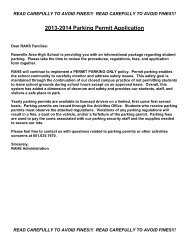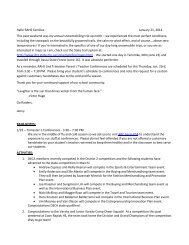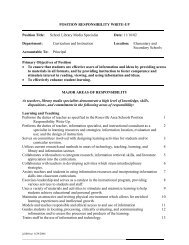Roseville Area Schools Local Literacy Plan for Reading Well by ...
Roseville Area Schools Local Literacy Plan for Reading Well by ...
Roseville Area Schools Local Literacy Plan for Reading Well by ...
Create successful ePaper yourself
Turn your PDF publications into a flip-book with our unique Google optimized e-Paper software.
District 623<br />
<strong>Roseville</strong> <strong>Area</strong> <strong>Schools</strong> <strong>Local</strong> <strong>Literacy</strong> <strong>Plan</strong><br />
This plan describes the <strong>Roseville</strong> <strong>Area</strong> <strong>Schools</strong>’ activities <strong>for</strong> implementation of the Minnesota<br />
Department of Education’s <strong>Reading</strong> <strong>Well</strong> <strong>by</strong> 3rd Grade initiative. Each section of this report<br />
aligns to required plan elements consistent with Statute 120B.12, as noted below. In an ef<strong>for</strong>t<br />
to address specifically every required plan element, the reader will notice redundancy of<br />
in<strong>for</strong>mation across some sections of the report. This is due to the interconnected nature of<br />
required elements.<br />
This plan describes current practices <strong>for</strong> the 2011-2012 school year, as well as direction <strong>for</strong> the<br />
2012-2013 school year. In places, specific areas of future work are noted, as the requirements<br />
of the <strong>Local</strong> <strong>Literacy</strong> <strong>Plan</strong> elements direct us to further develop or extend district work in the<br />
area of literacy.<br />
LOCAL LITERACY PLAN REQUIREMENTS SPECIFIED in Statute 120B.12:<br />
The public local literacy plan includes, at a minimum, the following items consistent with<br />
Statute 120B.12: (items listed in bold are plan components specified in Statute 120B.12.)<br />
Statement of goals or objectives defining how reading proficiency will be ensured <strong>for</strong> ALL<br />
students at each grade level Kindergarten through Grade 3<br />
<strong>Roseville</strong> <strong>Area</strong> <strong>Schools</strong> is committed to ensuring the reading proficiency of all students. <strong>Reading</strong><br />
<strong>Well</strong> <strong>by</strong> 3 rd Grade is one part of the district’s comprehensive ef<strong>for</strong>ts toward this goal.<br />
Description of current K-6 program<br />
In 2010-2011, <strong>Roseville</strong> <strong>Area</strong> <strong>Schools</strong> adopted a new comprehensive reading program. In grades<br />
K-3, materials from the <strong>Literacy</strong> <strong>by</strong> Design program <strong>for</strong>m the core of classroom materials used in<br />
our elementary schools.<br />
As with nearly all programs of this type, core program materials serve basic needs well <strong>for</strong> most<br />
students, but they do not meet the needs of all students. For example, a significant proportion<br />
of <strong>Roseville</strong>’s English learners (EL’s) is identified as Level I, or newcomer EL’s. These students<br />
speak little or no English, so basic classroom materials are not an appropriate fit <strong>for</strong> many<br />
instructional needs. Similarly, a significant proportion of our district population reads two or<br />
more years above grade level, and most comprehensive reading programs do not provide a<br />
range of materials that extend that far beyond grade level. Because our district population’s<br />
needs extend beyond what can be addressed effectively <strong>by</strong> core program materials,<br />
supplemental resources are sometimes required that allow teachers to differentiate instruction<br />
across the needs of all students.<br />
Since the 2007-2008 school year, <strong>Roseville</strong> <strong>Area</strong> <strong>Schools</strong> has been developing systemic<br />
structures and practices that are designed to provide all non-proficient (below grade level)<br />
students with targeted, intensified instruction that is likely to accelerate learning through our<br />
Pyramid of Interventions initiative. This approach is designed to provide increasingly focused<br />
and intensive instruction <strong>for</strong> students reading below grade level, with the strongest support<br />
targeted <strong>for</strong> students who read farthest below grade level.
The “pyramid” refers to a series of three tiers of support that are provided <strong>for</strong> all students who<br />
need it, but as students move through the tiers, support is more specific, often in increasingly<br />
smaller group sizes, and always with the most qualified available teacher.<br />
Tier I instruction is the first and most basic <strong>for</strong>m of support in the pyramid. It includes the<br />
regular daily instruction that all students receive as part of each school’s literacy program. Tier I<br />
instruction also includes differentiated support coordinated <strong>by</strong> the classroom teacher <strong>for</strong><br />
students who read below grade level. In many cases, Tier I support might mean that the teacher<br />
increases the number of times per week she or he meets with students being supported. This is<br />
somewhat like receiving an “extra scoop” of instruction, and we recognize that many students<br />
just need extra time practicing the same things in order to understand what is being taught.<br />
Tier II support is provided in addition to Tier I instruction, meaning students receive all that was<br />
being provided in Tier I plus additional support that is part of Tier II. Tier II instruction is typically<br />
provided in small group sizes of four students or less. Students often are grouped based on<br />
similar instructional needs, and instruction both extends and intensifies beyond Tier I<br />
instruction. An example of Tier II support might be when a teacher notices that a small group of<br />
students are struggling with an area of reading like inference. These students might receive<br />
additional support in the <strong>for</strong>m of specific, targeted instruction in this area.<br />
Tier III instruction is individualized one-on-one instruction <strong>for</strong> our students most in need of<br />
acceleration. Tier III instruction is intended to be provided in addition to Tier I and Tier II<br />
instruction. Currently in <strong>Roseville</strong>, Tier III support is provided in limited circumstances. For<br />
example, our district currently implements the <strong>Reading</strong> Recovery program, which provides<br />
individualized instruction but only <strong>for</strong> first grade students. Tier III support is the most difficult to<br />
provide because it typically is the most cost prohibitive and/or time intensive. We continue to<br />
explore ways to scale up opportunities <strong>for</strong> students who need this type of support.<br />
A variety of assessments are used across the year to help identify students who may need<br />
additional support, diagnose specific student needs, and monitor each student’s rate of progress<br />
(as detailed throughout this plan in other sections). When additional support is provided<br />
through the Pyramid of Interventions, accelerated growth is expected as an outcome. Typically<br />
we like to see students receiving intervention support to experience growth that is twice the<br />
national average in order <strong>for</strong> the support to be considered effective. When double growth is not<br />
seen, teachers often revise their plans to see if another approach can more strongly accelerate<br />
learning.<br />
Interventions are developed, described, and monitored through our district’s Collaborative<br />
Intervention <strong>Plan</strong>s (CIP’s). The CIP is a 6-10 week model <strong>for</strong> students receiving additional<br />
support. CIP’s are developed collaboratively within grade level team meetings, most often<br />
between classroom teachers and other support teachers who either help to develop the plan<br />
and/or provide some of the intervention support <strong>for</strong> students. CIP’s include plans <strong>for</strong> progress<br />
monitoring students at least as frequently as every two weeks. This way, adjustments can be<br />
made within each CIP during the flow of instruction, and in some cases on a daily basis.<br />
Various elements of our core instruction and Pyramid of Interventions work are elaborated in<br />
other parts of this plan.
Overall and disaggregated elementary (K-6) reading trends<br />
Overall K-6 reading trends are positive over the last four years, with last school year (2010-2011)<br />
being one of our best years ever <strong>for</strong> elementary schools based on proficiency (MCA-II <strong>Reading</strong>)<br />
and growth (MAP) results. According to the MAP <strong>Reading</strong> test, <strong>Roseville</strong> elementary students<br />
(K-6) experienced the highest rates of growth ever seen at the elementary level. MCA-II <strong>Reading</strong><br />
results <strong>for</strong> the same year reflected district proficiency rates <strong>for</strong> reading that were among our<br />
best ever.<br />
Disaggregated data show two trends significant to <strong>Reading</strong> <strong>Well</strong> <strong>by</strong> 3 rd Grade. First, within the<br />
tested grades in our elementary schools (grades 2-6 <strong>for</strong> MAP, and 3-6 <strong>for</strong> MCA-II <strong>Reading</strong>,<br />
respectively), grades 2 and 3 historically have per<strong>for</strong>med below our upper elementary grades in<br />
terms of growth. This may suggest some relative need <strong>for</strong> improvement in our lower<br />
elementary grades. Second, a large, historically persistent racial achievement gap has existed<br />
<strong>for</strong> <strong>Roseville</strong> students, with white students significantly outper<strong>for</strong>ming students of color every<br />
year we have tested. We have seen a slight decline in racial predictability across our elementary<br />
schools in the last four years (a reduction of about 4% in proficiency disparity between white<br />
students and students of color) and specifically in grade 3 (also about a 4% reduction), but race<br />
remains a powerful predictor of student per<strong>for</strong>mance in <strong>Roseville</strong>.<br />
<strong>Roseville</strong> <strong>Area</strong> <strong>Schools</strong> has selected as its district-identified proficiency measure the Benchmark<br />
Assessment System (BAS), a one-one-one assessment delivered <strong>by</strong> a teacher to an individual<br />
student. During the assessment students read a book with their teacher, and then have a<br />
conversation with the teacher to determine the student’s level of comprehension. Through<br />
BAS, each student is assigned an instructional reading level, which is the reading level that best<br />
matches each student’s current abilities.<br />
One advantage to using BAS as our district measure is its accuracy in predicting success on MCA-<br />
II <strong>Reading</strong> beginning in grade 3. Instructional reading levels in BAS are set to national average<br />
per<strong>for</strong>mance in each grade (50 th percentile). <strong>Local</strong> and national evidence tell us that typically<br />
between 80% - 90% of our district’s students who score at or above the 50 th percentile using<br />
other valid and reliable assessments go on to pass MCA-II <strong>Reading</strong>. Sampling of recent BAS<br />
scores suggests that the BAS is likely to give us similarly high rates of accuracy in predicting<br />
per<strong>for</strong>mance on MCA-II <strong>Reading</strong>.<br />
Given <strong>Roseville</strong>’s positive trends in reading (including a reduction in our racial achievement gap<br />
as measured <strong>by</strong> MCA-II <strong>Reading</strong>), our strong core program and Pyramid of Intervention work,<br />
and aligned assessments, we believe we are well positioned to help all of our students read<br />
proficiently <strong>by</strong> the end of their 3 rd grade year.<br />
Statement(s) of process to assess students' level of reading proficiency including assessments<br />
used, when administered, how proficiency is determined, and when and how results are<br />
communicated with parents of students in Kindergarten through Grade 3<br />
<strong>Roseville</strong> utilizes the Benchmark Assessment System (BAS) to identify students in grade K-3 who<br />
need targeted assistance to achieve grade level proficiency in the fall of each school year. The<br />
Benchmark Assessment System allows us to evaluate student reading and comprehension ability<br />
with a reliable and robust universal screening, and to determine each child's instructional level<br />
<strong>for</strong> guided reading according to the Fountas & Pinnell A-Z Text Level Gradient <strong>for</strong> guided
eading. This assessment is conducted in the winter and spring <strong>for</strong> students in kindergarten, in<br />
the fall, winter and spring <strong>for</strong> students in grade one, and is conducted at minimum in the fall and<br />
spring in grades two and three.<br />
Teachers use established district expectations to identify which students are predicted to be<br />
below grade level expectations <strong>by</strong> the spring of that school year based on assessment<br />
in<strong>for</strong>mation from the BAS. This data is shared with parents during winter conferences in grades<br />
K-3.<br />
For students in kindergarten, teachers conduct a series of assessments that measure student’s<br />
letter name and sound recognition and sight word recognition in the fall and winter, as well as<br />
phonemic awareness assessments. These assessments identify students <strong>for</strong> whom we suspect<br />
reading difficulty so that Tier II support can be offered to those children. This assessment data is<br />
shared with parents during the fall conference time. In first grade, 20% of the lowest<br />
per<strong>for</strong>ming first grade students are assessed using the Observation Survey <strong>by</strong> Marie Clay. These<br />
students are assessed in the fall and again in the winter. This data is used to determine which<br />
first grade students will receive <strong>Reading</strong> Recovery, a Tier III intervention, typically lasting <strong>for</strong> 12-<br />
14 weeks, that is supplemental to Tier I and Tier II instruction. This assessment data is shared<br />
with parents when their child begins <strong>Reading</strong> Recovery instruction. In second and third grade<br />
students take the NWEA-MAP test in reading in the fall, winter and spring. Teachers use the<br />
in<strong>for</strong>mation from the MAP test to identify students who score at or below the 33% in reading.<br />
Those students are then targeted <strong>for</strong> Tier II and Tier III intervention support. MAP testing data<br />
is sent home with students in the fall, and shared with parents at winter conferences.<br />
Once students have been identified as being as risk <strong>for</strong> not reaching grade level proficiency,<br />
Collaborative Intervention <strong>Plan</strong>s (CIP’s) are created which are designed to establish shared goals,<br />
intervention plans, progress monitoring and communication between all teachers involved in a<br />
child’s instruction. The intervention plans target specific reading skills and behaviors that<br />
teachers need to accelerate in order <strong>for</strong> the child to achieve proficiency. These plans are<br />
collaboratively developed <strong>by</strong> teams of teachers at that grade level. Progress monitoring is a<br />
critical element of the intervention plan, in order to evaluate the effectiveness of the<br />
interventions. The CIP is reviewed every 6-10 weeks, and progress monitoring data is used to<br />
determine if the interventions are successfully accelerating the student’s reading progress at a<br />
minimum of double growth.
Specific in<strong>for</strong>mation on how elementary schools within the district will notify and involve<br />
parents accelerating literacy development <strong>for</strong> their children in each grade Kindergarten<br />
through Grade 3<br />
In the Collaborative Intervention <strong>Plan</strong>ning process, teachers identify one or more areas of<br />
student strengths and needs based on the screening/diagnostic data. Teachers then establish<br />
goals based on students’ areas of greatest need. Potential goals are established in one or more<br />
of the following areas: phonemic awareness, word identification, comprehension, fluency,<br />
vocabulary, or the affective domain/motivation. Short term goals are set in order to accelerate<br />
the child’s achievement to two times typical growth, and long term goals are set to grade level<br />
per<strong>for</strong>mance in each area. Progress monitoring is conducted at least every two weeks to<br />
determine whether or not the intervention is resulting in the desired acceleration.<br />
As identified <strong>by</strong> the Collaborative Intervention <strong>Plan</strong>, a home school connection is made <strong>by</strong> a<br />
member of the intervention team, including a “home practice” element and an intentional<br />
communication point with the parent/guardian. The intervention plan directs the team to<br />
specify when the communication will occur, who will plan/prepare the communication and<br />
home practice element, what resources will be used, and who will implement or follow through.<br />
<strong>Reading</strong> is multidimensional. In order to accurately determine if students are adequately<br />
profiting from instruction and are in need of intervention, we triangulate our data from three<br />
sources (as available): MCA-II <strong>Reading</strong> (which provide useful in<strong>for</strong>mation on reading<br />
proficiency), NWEA-MAP (which provides a description of students’ academic growth) and<br />
Benchmark Assessment System (which provides essential in<strong>for</strong>mation on students’ reading<br />
behaviors and processing). Criteria <strong>for</strong> students in need of reading intervention are defined <strong>for</strong><br />
each of these three assessments, according to risk of reading difficulty <strong>for</strong> each.
Currently, most of the resources and tools available to parents of children who are not reading<br />
at or above grade level are communicated <strong>by</strong> their children’s teachers. Communication <strong>for</strong> all<br />
families occurs during regularly scheduled events such as parent-teacher conferences.<br />
However, as noted elsewhere in this report, individualized parent notification is expected<br />
whenever a student reads below grade level and/or the student is receiving reading intervention<br />
support through a Collaborative Intervention <strong>Plan</strong>. Classroom-specific resources and tools are<br />
communicated <strong>by</strong> each child’s teacher as part of the CIP planning process.<br />
Parent/caregiver/community resources and tools are among the areas of this plan we would like<br />
to develop more strongly during the 2012-2013 school year.<br />
Explain <strong>for</strong> a public audience what interventions and instructional supports will be available to<br />
students not reading at or above grade level in grades Kindergarten through Grade 3 and how<br />
these interventions will be based on learner data, including how services will be provided, and<br />
how parents will be in<strong>for</strong>med of student progress<br />
Interventions and supports are provided to students based on each student’s specific needs.<br />
The Collaborative Intervention <strong>Plan</strong> details the broad areas of support typically considered when<br />
assessing student need and designing intervention support:<br />
● Phonemic awareness<br />
● Word identification<br />
● Comprehension<br />
● Fluency<br />
● Vocabulary<br />
● Affective domain/engagement/motivation<br />
● Other (specify)<br />
The CIP also defines <strong>for</strong> each student a specific academic goal, the specific support instruction a<br />
student will receive, the method of monitoring progress, and a description of who will provide<br />
support (often a shared plan among multiple teachers).<br />
All students receive core instruction that is primarily drawn from the district’s core K-6 literacy<br />
program, as described in the introduction to this plan. While teachers are encouraged to use<br />
core materials flexibly and supplement the core when students’ needs fall outside of the range<br />
of materials provided in the classroom set, district administration communicates a clear<br />
expectation that core materials be used as the basis <strong>for</strong> instruction whenever appropriate.<br />
Essentially, the district’s core program is expected as the framework <strong>for</strong> instruction in our<br />
elementary grades.<br />
In grades 1-6, schools implement a literacy block of about 2 hours with slight variation across<br />
schools and classrooms occurring due to occasional scheduling obstacles. However, the amount<br />
of time provided <strong>for</strong> literacy is relatively consistent across all elementary schools. Because our<br />
district kindergarten program is a half-day program with options <strong>for</strong> all-day extension and<br />
enrichment, kindergarten students typically receive about 75 minutes of literacy instruction<br />
each day. Daily literacy instruction includes a mix of whole group and small group instruction.<br />
Whole group instruction often establishes a common theme within a class, while small group<br />
instruction allows students to apply skills within a common theme using texts at their individual<br />
levels.
State standards in English language arts drive our district’s instruction. Currently, <strong>Roseville</strong> uses<br />
the 2003 English language arts standards, but in compliance with direction from the Minnesota<br />
Department of Education will transition into implementation of the state’s new (2010) English<br />
language arts standards. A district team of K-6 teachers helped develop and lead training in our<br />
elementary schools this spring, in anticipation of this transition. Training included an overview<br />
of the new standards, district-created alignment documents that detail specific activities in each<br />
grade’s curriculum that align to all grade level benchmarks, and an overview of proposed<br />
changes to the district report card, which will take effect next school year.<br />
A range of assessments, as described elsewhere in this plan, is used to identify students who<br />
need additional reading support. The Collaborative Intervention <strong>Plan</strong> document guides teachers<br />
through the planning process and includes specific references to communicating with families<br />
and describing appropriate home practice suggestions. <strong>Roseville</strong> <strong>Area</strong> <strong>Schools</strong> recognizes that<br />
traditional modes of communication (<strong>for</strong>mal letters, official mailings) often are not read and/or<br />
understood <strong>by</strong> many of the families whose students are being served as part of a CIP. For this<br />
reason, the <strong>for</strong>m of communication is flexible as part of a CIP, but the expectation <strong>for</strong><br />
connecting with families is firm. Many teachers use phone or personal contact with families to<br />
both communicate in<strong>for</strong>mation about reading support and to establish better relationships<br />
between school and home. In<strong>for</strong>mal communication can sometimes work better <strong>for</strong> families<br />
because personal interaction allows <strong>for</strong> questions and discussion, while <strong>for</strong>mal notification may<br />
only serve to document student per<strong>for</strong>mance without allowing <strong>for</strong> authentic communication<br />
between school and home.<br />
<strong>Roseville</strong> <strong>Area</strong> <strong>Schools</strong> continues to experiment with new and innovative types of<br />
communication, such as translated letters, translation services through our district Language<br />
Line, support from cultural liaisons, etc.<br />
Describe how elementary teachers will participate in, and benefit from professional<br />
development on scientifically-based reading instruction<br />
Elementary teachers who have been continuously employed in the district have been part of<br />
professional development (PD) on scientifically-based reading instruction <strong>for</strong> the last four years,<br />
and professional development support will continue as we begin implementation of our <strong>Reading</strong><br />
<strong>Well</strong> <strong>by</strong> 3 rd Grade plan. More recently hired teachers have been part of ongoing training and<br />
often receive supplemental training in the most essential areas of literacy instruction (e.g.,<br />
training in the use of the Benchmark Assessment system) in addition to the district’s ongoing<br />
professional development.<br />
A specific district-level focus <strong>for</strong> professional development has been equity, addressing the<br />
longstanding racial achievement gap that has existed in our school district. Our historical<br />
per<strong>for</strong>mance data indicate that over a period of several years leading up to 2007-2008, the<br />
racial achievement disparity in reading between white students and students of color doubled<br />
from 14% to 28% according the MCA-II <strong>Reading</strong> proficiency. As of 2010-2011, the district-wide<br />
racial disparity has been cut <strong>by</strong> 4%, with more significant progress in our elementary grades.<br />
While the reductions to the achievement gap are encouraging, per<strong>for</strong>mance data suggest that<br />
focus in this area continues to be an intense need.
Equity professional development has been focused on two broad areas: teacher mindset and<br />
teacher skillset. Teacher mindset PD addresses the teacher beliefs, attitudes, and dispositions<br />
associated with accelerated student learning in general and the reduction of the achievement<br />
gap in particular. Equity skillset PD provides training in the methods and strategies associated<br />
with the same outcomes. An intended outcome of equity professional development is to help<br />
teachers understand that neither mindset nor skillset alone are sufficient, but that highly<br />
effective teachers tend to have strength in both areas. Consequently, equity PD sessions have<br />
been scheduled across the school year so that participants can continue their learning and<br />
connect experiences across both types of professional development.<br />
Over the past four years, the following PD activities have been provided <strong>for</strong> elementary<br />
teachers:<br />
● District-wide training in the use of the new K-6 literacy program<br />
● District-wide training in implementation of the new (2010) English language arts<br />
standards<br />
● District-wide training in the implementation of our Pyramid of Interventions initiative<br />
● District-wide equity training related to teacher skillset (effective practices, strategies)<br />
and mindset (effective attitudes, beliefs)<br />
● Regular work sessions that allow teachers to develop, monitor, and review Collaborative<br />
Intervention <strong>Plan</strong>s <strong>for</strong> students needing support in every elementary school<br />
● Access to coaching from a site-level or district-level reading specialist or literacy coach<br />
● Ef<strong>for</strong>ts to systematize practice <strong>by</strong> embedding intervention planning as part of each<br />
school’s regular meeting schedule (e.g., once-a-week grade level meetings to check in<br />
on CIP’s and student progress)<br />
● Ef<strong>for</strong>ts to provide past training to new hires<br />
● Teacher-specific, customized data reviews of student per<strong>for</strong>mance<br />
● Six of our seven elementary schools participate in the Alternative Teacher per<strong>for</strong>mance<br />
Pay System (ATPPS), which is <strong>Roseville</strong>’s merit pay system. For most buildings during<br />
most years, improvement in reading has been the goal. Teachers select professional<br />
teaching goals based on Charlotte Danielson’s Framework <strong>for</strong> Teaching. A target group<br />
of students is selected <strong>for</strong> intervention based on data gathered <strong>by</strong> the district<br />
assessment measures.<br />
In addition to the <strong>for</strong>mal training provided above, all elementary teachers have access to<br />
in<strong>for</strong>mal professional development through the support of reading coaches, intervention<br />
specialists, and/or district curriculum coordinators. This support includes, but is not limited to,<br />
opportunities <strong>for</strong> teachers to observe demonstration lessons, release time to work with other<br />
district teachers, chances to receive personalized coaching related to effective reading practices,<br />
access to additional teaching resources, or other services related to the improvement of reading<br />
instruction. Coaches also play a supporting role in the gathering and organization of student<br />
data in each school.<br />
Specifically describe how comprehensive scientifically based reading instruction consistent<br />
with section 122A.06, subdivision 4 is consistently implemented throughout elementary<br />
grades
<strong>Roseville</strong>’s core literacy program in grades K-3 is <strong>Literacy</strong> <strong>by</strong> Design. <strong>Literacy</strong> <strong>by</strong> Design is a<br />
standards-aligned, research supported program that addresses instruction in reading, writing,<br />
and oral language development (speak/view/listen). Except in rare cases (e.g., special education<br />
students who qualify <strong>for</strong> full replacement curriculum), all students in grades K-3 participate in<br />
the district’s core program. The program provides a mixture of whole-group and small-group<br />
experiences that allow <strong>for</strong> social inclusion of all students but also allows <strong>for</strong> differentiated,<br />
targeted instruction in small group settings so students can apply skills at their own<br />
developmental levels.<br />
Through ongoing assessment as described in other parts of this plan, student per<strong>for</strong>mance data<br />
is regularly reviewed. No more than every 6-10 weeks, teachers review classroom intervention<br />
plans to determine if below grade level students are making accelerated growth and/or to<br />
screen <strong>for</strong> additional students who may need to be added to intervention groups. The <strong>Literacy</strong><br />
<strong>by</strong> Design program includes bi-weekly theme tests that give teachers feedback about student<br />
per<strong>for</strong>mance compared to intended outcomes. This way, students who are not receiving<br />
support services are also monitored, preventing students who might “slip through the cracks”<br />
during the school year.<br />
Support <strong>for</strong> students is provided through a tiered system that intensifies and extends support<br />
<strong>for</strong> students if initial ef<strong>for</strong>ts are unsuccessful.<br />
● All students receive core instruction through the district program. Most students meet<br />
or exceed grade level expectations through core instruction only.<br />
● Tier I support: Students who are not responding as desired through the district program<br />
receive additional support as coordinated <strong>by</strong> the classroom teacher (Tier I support). In<br />
most cases, students receiving Tier I support continue being instructed in core<br />
instruction, and receive Tier I support in addition to the core.<br />
● Tier II support: Tier II support is provided <strong>for</strong> students who receive Tier I support but are<br />
not responding as desired. This level of support incorporates smaller student group<br />
sizes than in Tier I, and instruction is further targeted to specific areas of literacy<br />
acquisition. Tier II support is intended to be in addition to core instruction and Tier I<br />
support.<br />
● Tier III support: Tier III support is individualized, one-on-one support provided <strong>by</strong> the<br />
best qualified teacher(s) in a school. Currently, district resources (specifically, budget)<br />
allow us to provide very limited Tier III support in grade 1 through the <strong>Reading</strong> Recovery<br />
program. Individualized support of this nature is not yet available across grades K-3.<br />
Teacher training designed to support staff in the implementation of these practices has been<br />
ongoing over the last four years. During that time, district-level training has been scheduled<br />
during multiple professional development days each year. Over the last two years, as practices<br />
have become standardized across our elementary schools, training and support have shifted<br />
from district professional development days to site-level meeting times (e.g., all-staff meetings<br />
to review students’ academic progress, grade-level team meetings, etc.). Annual district<br />
timelines ensure an ongoing process to review data and use updated findings to shape decisions<br />
<strong>for</strong> each subsequent year of professional development. This not only helps to provide continuity<br />
of support across years, but as part of a broader planning process it helps to ensure that our<br />
support work in literacy is balanced against other district needs.
Also, training frequently happens as en embedded part of regular school activity. For example,<br />
each school has developed its own schedule that allows teams to plan and write Collaborative<br />
Intervention <strong>Plan</strong>s, as well as monitoring those plans across the year. These meetings are very<br />
often facilitated <strong>by</strong> a reading specialist or district coordinator with expertise in developing<br />
reading support. Consequently, training occurs as part of the planning process. Over the four<br />
year period of professional development described above, each school has embedded districtlevel<br />
training into regular, ongoing meeting schedules so that processes and training are<br />
integrated.<br />
A good research base exists supporting this professional development and the structures and<br />
supports we have created in recent years. A good starting place <strong>for</strong> readers of this report less<br />
familiar with the research is the RTI Action Network (www.rtinetwork.org), which provides links<br />
to studies and summary findings.<br />
Explain how training and support will be provided so that all district elementary teachers can<br />
effectively recognize students’ diverse needs in cross-cultural settings and serve the oral<br />
language and linguistic needs of EL students<br />
The <strong>Roseville</strong> <strong>Area</strong> <strong>Schools</strong> utilize a number of resources and methods <strong>for</strong> the continued growth<br />
of our staff related to the unique instructional needs related to our English Learners. The<br />
method of staff development takes two <strong>for</strong>ms <strong>for</strong> K-3 staff related to reading staff development.<br />
The first method of staff development is combined large group training on the reading process.<br />
Over the course of the past two school years, the EL teachers have worked as partners and coteachers<br />
in the domain of reading. These trainings have focused on the five elements of<br />
reading (phonemic awareness, phonics, fluency, vocabulary, comprehension) and direct<br />
instruction, which supports growth in these areas. The second method of training consists of<br />
staff development of classroom teachers related to WIDA standards in the language domains<br />
(<strong>Reading</strong>, Speaking, Listening, and Writing). One application of this implementation <strong>for</strong> staff<br />
development is the consistent use of Can Do descriptors <strong>by</strong> all K-3 education staff. These Can<br />
Do Descriptors encourage common professional language related to increasing student<br />
proficiency through aligned staff ef<strong>for</strong>t.<br />
A second layer of the staff development <strong>for</strong> all instructional staff related to the needs of English<br />
Learners is training on methods of instructional delivery. Two common methods of instructional<br />
delivery are used in our district with K-3 students and staff; pull-out EL instruction and coteaching.<br />
The staff development <strong>for</strong> pull-out instruction rests primarily with the licensed EL<br />
teacher. Staff development outcomes <strong>for</strong> this method rest primarily in communication of<br />
instructional outcomes and progress. The second method of instruction is much more staff<br />
development focused with the classroom and reading teachers. All buildings and staff<br />
implementing co-teaching methods will have targeted staff development and planning time<br />
related to the unique <strong>for</strong>ms that this type of EL instruction can take in a school.<br />
District-wide professional development in the areas of equity mindset and equity skillset work<br />
complement the more EL-specific types of training described above. Equity mindset training<br />
refers to the teacher beliefs, dispositions, and orientations that are most associated with<br />
reductions in the achievement gap. Equity skillset work refers to the learning of new techniques<br />
and instructional strategies that reduce the achievement gap. All teachers participate in both<br />
mindset and skillset sessions across the school year. Currently, district professional
development activities are being planned <strong>for</strong> 2012-2013, but early discussions suggest that a<br />
strong focus on equity mindset is likely to continue, with equity skillset being presented on<br />
various topics from which teachers might choose.<br />
Finally, one <strong>Roseville</strong> school (Central Park) has received extremely intense support and training<br />
around the needs of English Learners. This is due to Central Park’s student population, which<br />
has our highest concentration of “newcomers”, or students who are new to English. Central<br />
Park has been developing a sheltered content model in which EL newcomers are clustered<br />
within single classrooms in each grade, and the teachers in these classes implement aspects of<br />
the Shelter Instruction Observational Protocol (SIOP) model, an instructional model specific to<br />
English Learners. The model was first implemented this school year (2011-2012), with plans to<br />
continue the plan next year. Initial results have been promising, with academic growth as<br />
reflected through MAP testing indicating the English Learners at Central Park are enjoying some<br />
of the highest rates of growth in our district this year.<br />
Post assessment methods and data that is submitted to Commissioner annually including<br />
objectives of assessment program, names of tests, grade levels of administration as part of<br />
local literacy plan on district webpage <strong>for</strong> all students in Kindergarten through Grade 3<br />
As required through <strong>Reading</strong> <strong>Well</strong> <strong>by</strong> 3rd Grade, a central objective of our assessment program<br />
in grades kindergarten through 3rd grade is to determine with a high degree of confidence if<br />
students are trending toward grade-level proficiency in 3rd grade as determined <strong>by</strong> MCA-II<br />
<strong>Reading</strong>. District summative results are submitted to the Commissioner annually; other types of<br />
assessment (screening, diagnostic, progress monitoring) are used as check points across the<br />
school year to determine if groups of students and/or individuals are on track.<br />
<strong>Roseville</strong> has selected the Benchmark Assessment System (BAS) as our district proficiency<br />
measure <strong>for</strong> all grades K-3, as part of our local literacy plan. BAS yields an instructional reading<br />
level <strong>for</strong> each student, which is a composite measure, derived from a combination of reading<br />
accuracy, fluency, and comprehension. <strong>Roseville</strong> has selected end-of-grade reading targets that<br />
are set to approximately the 50th percentile in each grade. We have seen locally that around<br />
90% of our district’s students who per<strong>for</strong>m at or above the 50th percentile on various normreferenced<br />
assessments also are proficient on the MCA-II <strong>Reading</strong> in tested grades. This high<br />
degree of predictability is a preferred quality of our district proficiency measure.<br />
End-of-year BAS assessments are completed during May of each school year. Teachers enter<br />
results into our electronic reporting system (the same system used to generate report cards).<br />
District results are exported in spreadsheet <strong>for</strong>m <strong>for</strong> reporting purposes.<br />
Because district results are compiled literally within days of the end of our school year, districtwide<br />
sharing is not possible in an organized way until fall of the following school year. Also,<br />
because some of our district processes are new this year (as a result of <strong>Reading</strong> <strong>Well</strong> <strong>by</strong> 3rd<br />
Grade), some district-wide sharing of this nature will happen <strong>for</strong> the first time next school year.<br />
It is anticipated that organized district-wide sharing may occur during our district’s data camp in<br />
August and continue into the first weeks of school.


